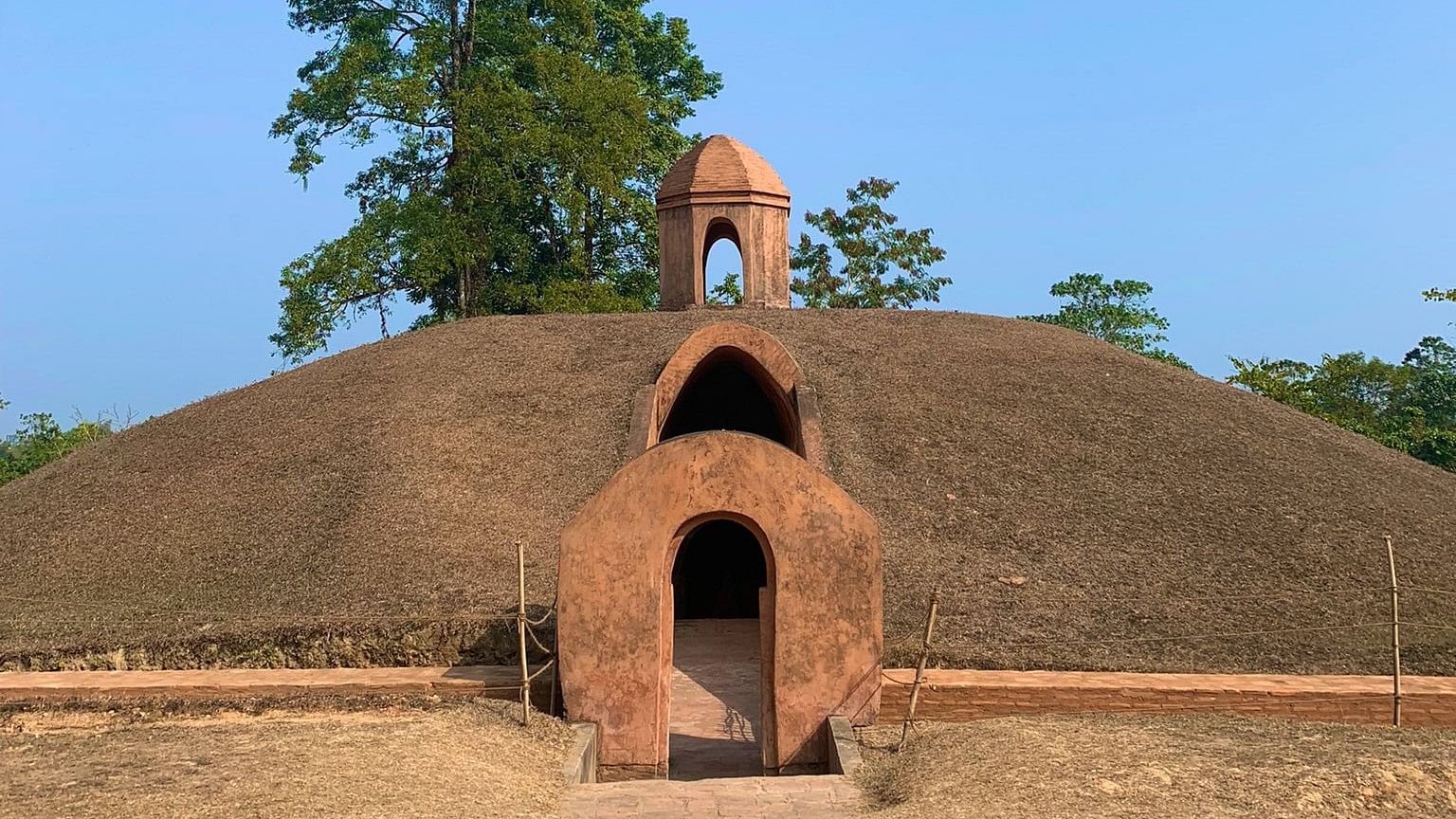
India's nomination - 'Moidams' - for the year 2023-24 is set to be examined under the category of cultural property.
Credit: X/@abhishekporaxar
New Delhi: An advisory body to the UNESCO has recommended that "Moidams" -- a mound-burial system of the Ahom dynasty in Assam -- be included in the World Heritage List, according to a top Archaeological Survey of India (ASI) official.
The 46th session of the World Heritage Committee (WHC), to be held in New Delhi from July 21 to July 31, will examine 27 nominations from across the world, including 19 cultural sites, four natural sites and two mixed sites, according to information shared by the culture ministry.
Of these, India's nomination -- "Moidams" -- for the year 2023-24 is set to be examined under the category of cultural property.
Replying to a reporter's query at a press conference here on Friday, Janhwij Sharma, Additional Director General, ASI, said a site has to fulfil certain conditions in order to get the "world heritage" tag from the UNESCO.
"The ICOMOS has recommended favourably for inscription of Moidams, which means it fulfils all those parameters," he said.
The Paris-based International Council on Monuments and Sites (ICOMOS) is one of the key advisory bodies to the UNESCO and its experts visit the nominated sites.
Vishal V Sharma, chairperson of the WHC and ambassador and permanent representative of India to the UNESCO, told the press conference that if the nomination is accepted, it will be the first cultural property from the northeast to get a UNESCO tag, adding that the Kaziranga National Park and the Manas National Park fall in the natural and mixed heritage categories respectively.
The mound-burial system of the Ahom dynasty has been submitted as India's nomination for inclusion in the UNESCO World Heritage List for the year 2023-24, the Centre informed Parliament in December.
The unique burial mounds, represented by pyramid-like structures known as "moidams", were used by the Tai-Ahom dynasty that ruled Assam for around 600 years.
In a written reply to a question in the Rajya Sabha, the then Union Minister for Culture and Tourism G Kishan Reddy had shared information about the nomination.
"Selection of sites or properties for World Heritage nomination depends upon its Outstanding Universal Value (OUV), authenticity and integrity. These sites must fulfil one of the criteria of OUV as mentioned in the UNESCO Operational Guidelines, 2023," he had said.
"Moidams" are vaulted chambers (chow-chali), often double-storied, that have an arched passage for entry. Atop the hemispherical mud mounds, layers of bricks and earth are laid. The base of the mound is reinforced by a polygonal toe-wall and an arched gateway on the west, according to the UNESCO website.
"Eventually, the mound would be covered by a layer of vegetation, reminiscent of a group of hillocks, transforming the area into an undulating landscape," the description of "moidams" said.
Excavation shows each vaulted chamber has a centrally raised platform where the body was laid. Several objects used by the deceased during his life, like royal insignia, objects made of wood, ivory or iron, gold pendants, ceramic ware, weapons, clothes to the extent of human beings (only from the Luk-kha-khun clan) were buried with their king, according to the website.
During a presentation, Sharma also said the WHC session could not take place in China in 2021 due to Covid-19 and it did not take place in Russia in 2022.
More than 2,000 international and national delegates from over 150 countries are expected to participate in the mega event in Delhi, he told reporters.
A number of side events are also being hosted by India as well as some other countries.
A shopping experience for indigenous craft products is planned, besides excursions and tours and a plan to showcase India's digital expertise, Sharma said.
The tourism ministry has curated exhibitions and so have the ministries of railways, mines, electronics and information technology, as well as exhibitions of handlooms and handicrafts.
The Maharashtra government has planned 13 scaled models of forts related to Maratha ruler Chhatrapati Shivaji.
Also, a virtual experience of three UNESCO sites in India -- Rani Ki Vav of Gujarat, the Kailash temple of the Ellora caves in Maharashtra and the Halebidu temple of south India -- will be created "inside a cell".
Work on beautifying areas in and around Bharat Mandapam, which will host the session, is underway.
Asked about multiple nominations from a neighbouring country, Sharma said, "According to the operational guidelines, paragraph 61 stipulates that one dossier per country per year is permitted."
The WHC in Riyadh last year had suspended paragraph 61, with the rationale that due to Covid restrictions, certain sites could not be visited, so that country had missed certain slots.
Besides the plenary session at Bharat Mandapam, parallel meetings have also been scheduled at the 46th session of the WHC, including the World Heritage Young Professionals' Forum and the World Heritage Site Managers' Forum.
The World Heritage Young Professionals' Forum, running from July 14 to July 23, brings young people and heritage experts together to foster intercultural learning.
The World Heritage Site Managers' Forum is being held from July 18 to July 25. It focuses on the importance of collaborative and sustainable management practices.